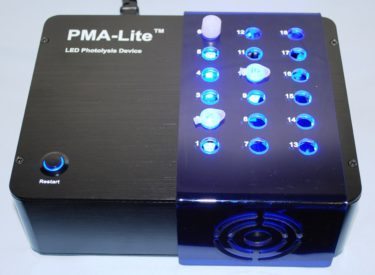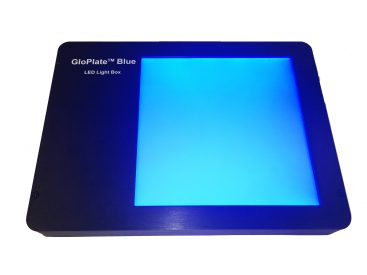Content #1
Content #1
Content #1
A photo-activated fluorescent nucleic acid binding dye used to selectively and covalently label dead cells in the presence of live cells for viability PCR, fluorescent microscopy, and flow cytometry.
When not activated or bound to DNA, Ethidium monoazide bromide (EMA) is a non-fluorescent nucleic acid stain with a photoaffinity label. Once photoactivated, the dye binds covalently to nucleic acids and can emit fluorescence. The dye is most often used to label dead cells in a mixed population of live and dead cells.
Because EMA is relatively impermeant to live cells, it selectively binds DNA in dead cells. Photolysis renders the dead cell DNA covalently labeled with the dye. One can then wash and fix the cell preparation for analysis by microscopy, fluorescence plate reader or flow cytometry. The dye has been used to footprint drug binding sites on DNA, to modify plasmid DNA, and for labeling yeast cells for leukocyte phagocytosis assays. The major advantage of this method is that researchers can avoid extensive manipulation of live pathogenic organisms. EMA has been used to differentiate between viable and dead bacteria by 5′-nuclease PCR.
Switching from agar plates to v-PCR is a great way to speed up bacteria viability testing. There are some things that you will need to know and take into consideration before you switch to the v-PCR method. For viability PCR applications, Ethidium monoazide (EMA) is the most cell-permeable, and may result in false negatives. Propidium monoazide (PMA), developed at Biotium, is the most widely-used dye, so there are many protocols and publications available for reference. PMAxx™ is designed be superior to PMA and EMA as well as compatible with existing PMA protocols. PMAxx™ has better differentiation of live and dead bacteria and therefore it is more selective for dead cell labeling for v-PCR quantitation of bacteria. See the PMA & PMAxx™ Reference List and PMA & PMAxx™ Validated Bacterial Strains. For more information about v-PCR, see our blog post.
To more easily get started with viability PCR, learn about our customizable Viability PCR Starter Kits. You choose which viability PCR dye you prefer, and whether or not you need Enhancer for gram-negative bacteria. All of the starter kits come with an EvaGreen® qPCR master mix and a detail protocol to get you started.
Biotium also provides strain-specific Real-Time PCR Bacterial Viability Kits with validated primers for selected pathogens: M. tuberculosis, S. aureus, MRSA, Salmonella, E. coli, E. coli O157:H7, Legionella and Listeria. These kits provide everything that you need for the selective detection of your favorite species of live bacteria by real-time v-PCR.
Biotium sells two devices for the photolysis step of viability PCR. The PMA-Lite™ LED photolysis device is designed for PMAxx™-, PMA-, and EMA-treated samples in microcentrifuge tubes. The Glo-Plate™ Blue is a flat LED box ideal for samples in microplates, filters, or other formats.
 PMA-Lite™ LED photolysis device, for photoactivation of PMAxx™, PMA, or EMA
PMA-Lite™ LED photolysis device, for photoactivation of PMAxx™, PMA, or EMA Glo-Plate™ Blue LED Illuminator for photoactivation of PMAxx™, PMA, and EMA
Glo-Plate™ Blue LED Illuminator for photoactivation of PMAxx™, PMA, and EMANote: Do not remove the cover or introduce liquids to the interior of the PMA-Lite.
The LEDs in the PMA-Lite™ and PMA-Lite™ 2.0 have a wavelength that is 465-475 nm and a brightness of approximately 600-800 millicandela (mcd). These are nominal values provided for reference use only, individual LED wavelength and brightness are not a calibrated specifications for the device.
There are three LEDs in each well (one bottom, two side) that provide illumination around each sample tube for efficient photoactivation.
The illumination in each well on the PMA-Lite far exceeds what is required for photocrosslinking of the viability dyes EMA, PMA, or PMAxx™ to nucleic acids. Therefore, any variability in brightness of the PMA-Lite LEDs should not significantly affect the v-PCR results. If performance verification is required, we recommend doing a functional PMA-PCR assay to verify that PMA-treated samples photoactivated in the device give qPCR results within an acceptable range. Mixing the samples during photoactivation and using longer illumination times may be necessary if the samples are complex and not fully transparent to light.
For other related FAQs, see Is illumination even across all positions in the PMA-Lite™ device? and Can I use PMA or PMAxx™ with environmental samples?
PMA is stable after dilution to 0.2 mM in water as long as it is protected from light and can be stored in the same way as the 20 mM stock solution.